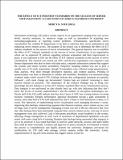The Effect of ICT Industry Standards on the Success of Server Virtualization- A Case Study of Africa Nazarene University
Abstract
Information technology (IT) policy certain aspects in an organization ranging from user access levels, security measures, to resources usage as well as procedures of acquiring new technology/application or reporting system problems. Virtualization, specifically server virtualization has enabled IT departments to be able to optimize their server performance and enhancing server remote access. The purpose of the project was to determine the effect of ICT industry standards on the success of server virtualization. The general objective was to establish the effect of ICT industry standards on the success of server virtualization. In an organization where are no approved IT policies regarding software acquisition and their improvement in place, it was important to fine out the effect of ICT industry standards on the success of server virtualization. The research was carried out ANU, and the key respondents were registrar’s and finance department who deal on basis with data entry, computer information systems that support the systems and ensure systems availability. Purposive sampling method was use to pick a sample size of 35 study respondents, though 31respondent were collected using questionnaires. Data analysis. Was done through descriptive statistics, and content analysis. Piloting of questionnaires was done to determine it validity and reliability. Reliability was measured using cronbach alpha which scored 0.759. Findings indicate that configuration standards are partially followed , with most change not documented. System logs are tracked; reviewing is more reactive instead of proactive. The importance of the research findings was to bring new knowledge into the industry as to how ICT industry standard affect server virtualization success. Data integrity is not performed on data already back up, with also indicating that they don’t know the levels of security authentication’s and the number of encryption technologies use. Nearly half of the CIS staffs indicate that they don’t know if ANU has existing policies covering business continuity. Despite performance appraisal documents having a gaps assessment is section, more than half of CIS staff indicated they don’t if there is skill assessment is done, or it exists. The objectives of implementing server visualization were managing electronic e-waste, improving data backups, improvising response time between systems, server remote access, cost servings, ease of server management. Managing e-waste was one of the key objectives that were met, data backups have been automated, response time, servers remote access, cost ease of server management were also achieved. Lack of document procedures create loopholes in the system, affecting change management as well. Lack of awareness of departmental operations was also noted, with some citing lack of training. Despites data backups being automated, data integrity is yet to be achieved. It was noted that there is need for audit (network, security and staffs skills) that could be done externally. Creation and approval of policy should be re-evaluated to ensure the process is comprehensive and legally protects the university. Budgetary provisions for certifications by CIS staff who manage critical systems within the university. Lastly, implementation of log and event monitor that triggers alarms if need be.
Publisher
Africa Nazarene University

